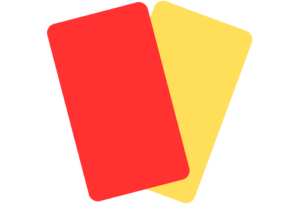Understanding the Red Card in Volleyball: Rules and Consequences

Volleyball, just like other sports relies on a set of rules to maintain fairness and sportsmanship on the court. One crucial aspect of these rules is the issuance of cards, particularly the infamous red card.
In this article, we will delve into the rules surrounding the red card in volleyball and the consequences it carries.
The Purpose of Cards in Volleyball
Before we explore the specifics of the red card, it’s essential to understand the broader context of cards in volleyball. Like many other sports, volleyball utilizes cards as a means of officiating and maintaining control during a match. These cards come in different colors, each serving a unique purpose.
In volleyball, the most commonly used cards are yellow and red. A yellow card is a warning issued to a player or coach for minor infractions or misconduct. It serves as a caution, signaling that further violations could result in more severe consequences. On the other hand, the red card is a more serious disciplinary action and its implications extend beyond the match itself.
When is a Red Card Issued?
A red card in volleyball is not handed out lightly; it signifies a significant violation of the rules or an extreme act of misconduct. The circumstances under which a red card may be issued include, but are not limited to:
Aggressive Behavior: Any form of physical aggression, whether directed towards opponents, teammates, officials, or spectators, can result in a red card. This includes actions such as hitting, kicking, or any other aggressive physical contact.
Verbal Abuse: Volleyball is a sport that values sportsmanship and respect. Verbal abuse, whether directed at opponents, teammates, or officials, is grounds for a red card. This includes the use of offensive language, insults, or any form of disrespectful communication.
Refusing to Leave the Court: If a player or coach refuses to comply with an official’s decision or fails to leave the court when required to do so, a red card may be issued.
Repeated Misconduct: Accumulating multiple yellow cards throughout a match may lead to an automatic red card. This emphasizes the importance of heeding warnings and adjusting behavior accordingly.
Consequences of Receiving a Red Card
Receiving a red card in volleyball carries significant consequences, both immediate and long term. The immediate consequences affect the ongoing match, while the long term repercussions may impact future games and the overall reputation of the player or coach.
Immediate Expulsion: The most immediate consequence of a red card is the expulsion of the player or coach from the ongoing match. This means the team must continue without the disqualified individual, putting them at a numerical disadvantage.
Forfeiture of Points: In addition to the expulsion, the opposing team is often awarded points as a result of the red card. The number of points awarded may vary depending on the severity of the misconduct.
Suspension and Fines: A red card doesn’t only affect the current match. It often results in a suspension for the next match or matches, depending on the gravity of the offense. In some cases, fines may also be imposed on the individual or the team.
Impact on Team Morale: Beyond the numerical disadvantage and immediate consequences, a red card can have a profound impact on the morale of the entire team. Teammates may be demoralized and the disrupted focus can hinder performance.
Reputation Damage: In the world of sports, reputation matters. Receiving a red card for unsportsmanlike conduct can tarnish a player or coach’s reputation, affecting future opportunities and casting a shadow over their career.
Appealing a Red Card Decision
While the decision to issue a red card is ultimately at the discretion of the officials, there is a process for appealing such decisions. Teams or individuals who believe a red card was unjustly issued can submit an appeal to the governing body overseeing the competition. The appeal process typically involves reviewing video footage, statements from all parties involved and any additional evidence that may shed light on the situation.
It’s crucial to note that frivolous or unfounded appeals can result in additional penalties. The appeal process is designed to address genuine concerns and ensure fairness, not to challenge every red card decision on a whim.
The Importance of Sportsmanship in Volleyball
Understanding the rules and consequences associated with the red card in volleyball underscores the broader importance of sportsmanship in the sport. Volleyball, like any competitive activity, thrives on a foundation of mutual respect, fair play and adherence to rules.
Players, coaches and officials all play pivotal roles in upholding the spirit of the game. Embracing good sportsmanship not only ensures a positive experience for everyone involved but also contributes to the growth and popularity of volleyball as a sport.
Conclusion
In conclusion, the red card in volleyball is a serious disciplinary measure reserved for significant rule violations or acts of misconduct. Understanding the circumstances under which a red card may be issued and the consequences it carries is crucial for players, coaches and anyone involved in the sport. Volleyball’s commitment to fair play and sportsmanship is upheld through these disciplinary measures, emphasizing the importance of mutual respect and adherence to the rules on and off the court.

